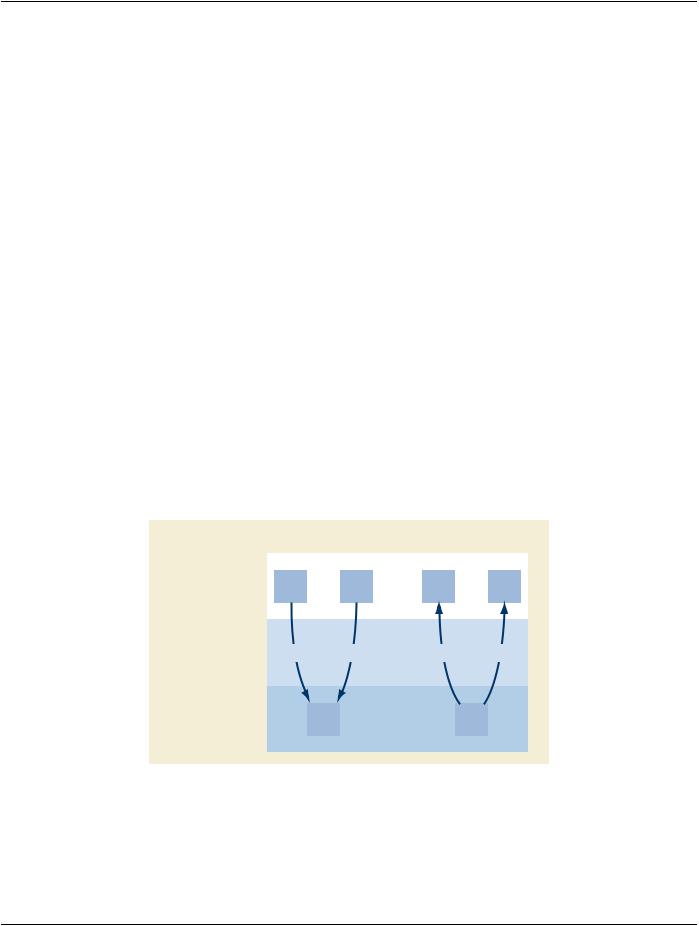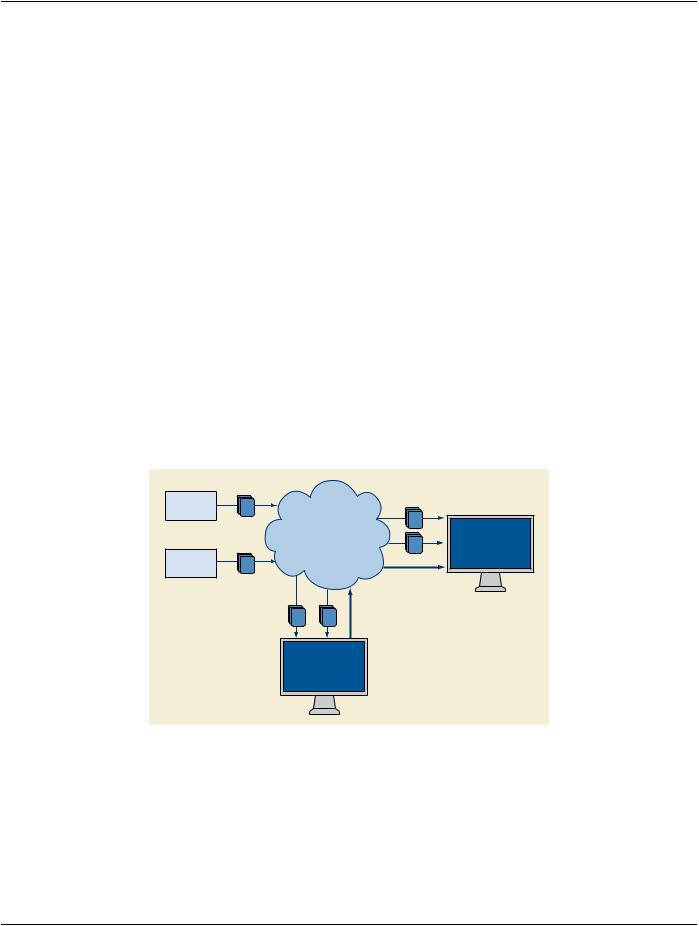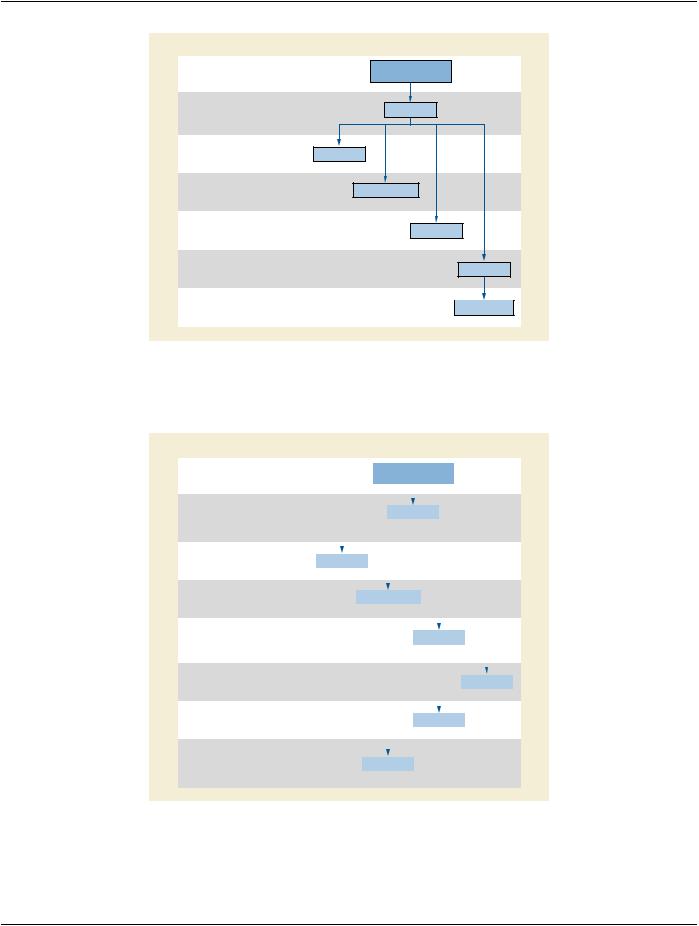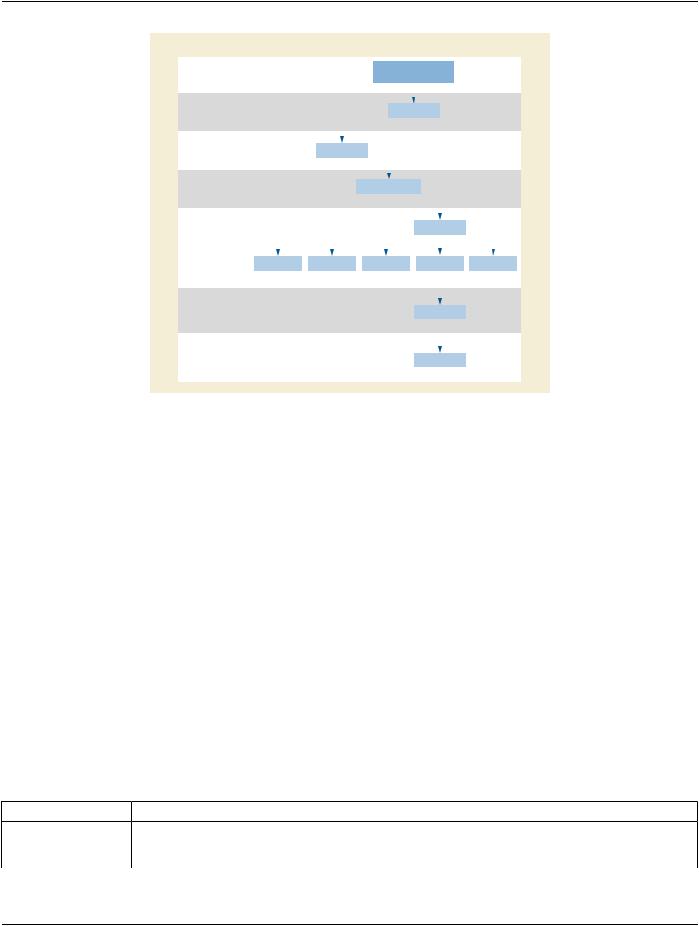
PS-2020a / part17
.pdf
|
DICOM PS3.17 2020a - Explanatory Information |
|
Page 181 |
||
Nest |
Code Meaning of Concept Name |
Code Meaning or Example |
|
TID |
|
|
|
|
Value |
|
|
>> |
Finding Site |
|
Left Ventricle |
TID 5202 |
|
>> |
Measurement Group |
|
|
TID 5202 |
|
>> |
Image Mode |
|
2D |
TID 5202 |
|
>>> |
Heart Rate |
|
89 bpm |
TID 5202 |
|
>>> |
Left Ventricular End Diastolic Volume |
38.914 ml |
TID 5202 |
|
|
>>>> |
Measurement Method |
|
Teichholz |
TID 5202 |
|
>>> |
Left Ventricular End Systolic Volume |
|
12.304 ml |
TID 5202 |
|
>>>> |
Measurement Method |
|
Teichholz |
TID 5202 |
|
… |
… |
|
… |
… |
|
>>> |
Stroke Volume |
|
26.6 ml |
TID 5202 |
|
>>>> |
Anatomic Site |
|
Left Ventricle |
TID 5202 |
|
>>> |
Stroke Index |
|
13.49 ml/m2 |
TID 5202 |
|
>>>> |
Anatomic Site |
|
Left Ventricle |
TID 5202 |
|
>>> |
Cardiac Output |
|
2.37 l/min |
TID 5202 |
|
>>>> |
Anatomic Site |
|
Left Ventricle |
TID 5202 |
|
>>> |
Cardiac Index |
|
1.20 l/min/m2 |
TID 5202 |
|
>>>> |
Anatomic Site |
|
Left Ventricle |
TID 5202 |
|
>>>> |
Index |
|
BSA |
TID 5202 |
|
>>> |
Left Ventricular Ejection Fraction |
|
68.4 % |
TID 5202 |
|
>>> |
… |
|
|
… |
|
N.4.6 Example 6: Wall Scoring |
|
|
|
|
|
Nest |
Code Meaning of Concept Name |
Code Meaning or Example Value |
TID |
||
|
Adult Echocardiography Procedure |
|
|
TID 5200 |
|
|
Report |
|
|
|
|
> |
…. |
|
|
… |
|
> |
Findings |
|
|
TID 5204 |
|
>> |
Procedure Reported |
Echocardiography for DeterminingTID 5204 |
|
||
|
|
Ventricular Contraction |
|
|
|
>> |
Stage |
Pre-stress image acquisition |
TID 5204 |
|
|
>> |
LV Wall Motion Score Index |
1.0 |
TID 5204 |
|
|
>>> |
Assessment Scale |
5 Point Segment Finding Scale |
TID 5204 |
|
|
>> |
Findings |
|
|
TID 5204 |
|
>>> |
Wall Segment |
Basal anterior |
TID 5204 |
|
|
>>>> |
Wall motion finding |
Normal |
TID 5204 |
|
|
>>> |
Wall Segment |
Basal anteroseptal |
TID 5204 |
|
|
>>>> |
Wall motion finding |
Normal |
TID 5204 |
|
|
>>> |
Wall Segment |
Basal inferoseptal |
TID 5204 |
|
|
>>>> |
Wall motion finding |
Akinetic |
TID 5204 |
|
|
… |
… remaining segments … |
|
|
TID 5204 |
|
> |
Wall Motion Analysis |
|
|
TID 5204 |
|
- Standard -

Page 182 |
DICOM PS3.17 2020a - Explanatory Information |
|
|
|
Nest |
Code Meaning of Concept Name |
Code Meaning or Example Value |
TID |
|
>> |
Stage |
Peak-stress image acquisition |
TID 5204 |
|
>> |
LV Wall Motion Score Index |
1.23 |
TID 5204 |
|
>>> |
Assessment Scale |
5 Point Segment Finding Scale |
TID 5204 |
|
>> |
Findings |
|
TID 5204 |
|
>>> |
Wall Segment |
Basal anterior |
TID 5204 |
|
>>>> |
Score |
Hypokinesis |
TID 5204 |
|
>>> |
Wall Segment |
Basal anteroseptal |
TID 5204 |
|
>>>> |
Score |
Akinetic |
TID 5204 |
|
>>>> |
Morphology |
Scar / Thinning |
TID 5204 |
|
>>> |
Wall Segment |
Basal inferoseptal |
TID 5204 |
|
>>>> |
Score |
Normal |
TID 5204 |
|
… |
… remaining segments … |
|
TID 5204 |
|
N.5 IVUS Report
The IVUS Report contains one or more vessel containers, each corresponding to the vessel (arterial location) being imaged. Each vessel is associated with one or more IVUS image pullbacks (Ultrasound Multi-frame Images), acquired during a phase of a catheter- ization procedure. Each vessel may contain one or more sub-containers, each associated with a single lesion. Each lesion container includes a set of IVUS measurements and qualitative assessments. The resulting hierarchical structure is depicted in Figure N.5-1.
|
|
IVUS Report |
|
|
|
(CONTAINER) |
|
CONTAINS |
CONTAINS |
CONTAINS |
CONTAINS |
Vessel |
Vessel |
Vessel |
Image Library |
(CONTAINER) |
(CONTAINER) |
(CONTAINER) |
(CONTAINER) |
CONTAINS
Image Reference
IMAGE
CONTAINS
Image Reference
IMAGE
CONTAINS |
HAS OBS CONTEXT |
HAS OBS CONTEXT |
CONTAINS |
CONTAINS |
|
Lesion |
Arterial Location |
Procedure Phase |
Vessel Morphology |
Vessel Findings |
|
(CONTAINER) |
|||||
|
|
|
|
||
HAS OBS CONTEXT |
CONTAINS |
CONTAINS |
CONTAINS |
CONTAINS |
|
Lesion Location |
Qualitative |
IVUS Measurements |
Device Used |
Findings |
|
Assessments |
|||||
|
|
|
|
Figure N.5-1. IVUS Report Structure
- Standard -

DICOM PS3.17 2020a - Explanatory Information |
Page 183 |
O Registration (Informative)
O.1 Spatial Registration and Spatial Fiducials SOP Classes
These SOP Classes allow describing spatial relationships between sets of images. Each instance can describe any number of regis- trations as shown in Figure O.1-1. It may also reference prior registration instances that contribute to the creation of the registrations in the instance.
A Reference Coordinate System (RCS) is a spatial Frame of Reference described by the DICOM Frame of Reference Module. The chosen Frame of Reference of the Registration SOP Instance may be the same as one or more of the Referenced SOP Instances. In this case, the Frame of Reference UID (0020,0052) is the same, as shown by the Registered RCS in the figure. The registration information is a sequence of spatial transformations, potentially including deformation information. The composite of the specified spatial transformations defines the complete transformation from one RCS to the other.
Image instances may have no DICOM Frame of Reference, in which case the registration is to that single image (or frame, in the case of a Multi-frame Image). The Spatial Registration IOD may also be used to establish a coordinate system for an image that has no defined Frame of Reference. To do this, the center of the top left pixel of the source image is treated as being located at (0, 0, 0). Offsets from the first pixel are computed using the resolution specified in the Source IOD. Multiplying that coordinate by the Trans- formation matrix gives the patient coordinate in the new Frame of Reference.
A special case is an atlas. DICOM has defined Well-Known Frame of Reference UIDs for several common atlases. There is not ne- cessarily image data associated with an atlas.
WhenusingtheSpatialRegistrationorDeformableRegistrationSOPClassestherearetwotypesofcoordinatesystems.Thecoordinate system of the referenced data is the Source RCS. The coordinate system established by the SOP instance is the Registered RCS.
ThesenseofthedirectionoftransformationdiffersbetweentheSpatialRegistrationSOPClassandtheDeformableSpatialRegistration SOP Class. The Spatial Registration SOP Class specifies a transformation that maps Source coordinates, in the Source RCS, to Registered coordinates, in the Registered RCS. The Deformable Spatial Registration SOP Class specifies transformations that map Registered coordinates, in the Registered RCS, to coordinates in the Source RCS.
The Spatial Fiducials SOP Class stores spatial fiducials as implicit registration information.
Spatial Registration |
Deformable |
|
Spatial Registration |
||
|
SOURCE |
RCS-1 |
|
RCS-2 |
|
RCS-1 |
|
RCS-2 |
|
|
|
|
|
|
|
|
TRANSFORMATIONS |
M1T |
M2T |
Δ+M3T |
Δ+M4T |
REGISTERED |
RCS-1 |
|
RCS-2 |
|
|
|
|
Figure O.1-1. Registration of Image SOP Instances
O.2 Functional Use Cases
Multi-Modality Fusion: A workstation or modality performs a registration of images from independent acquisition modalities-PET, CT, MR, NM, and US-from multiple series. The workstation stores the registration data for subsequent visualization and image pro- cessing. Such visualization may include side-by-side synchronized display, or overlay (fusion) of one modality image on the display
- Standard -

Page 184 |
DICOM PS3.17 2020a - Explanatory Information |
of another. The processes for such fusion are beyond the scope of the Standard. The workstation may also create and store a ready- for-displayfusedimage,whichreferencesboththesourceimageinstancesandtheregistrationinstancethatdescribestheiralignment.
Prior Study Fusion: Using post processing or a manual process, a workstation creates a spatial object registration of the current Study's Series from prior Studies for comparative evaluation.
AtlasMapping:AworkstationoraCADdevicespecifiesfiducialsofanatomicalfeaturesinthebrainsuchastheanteriorcommissure, posteriorcommissure,andpointsthatdefinethehemisphericfissureplane.ThesystemstoresthisinformationintheSpatialFiducials SOP Instance. Subsequent retrieval of the fiducials enables a device or workstation to register the patient images to a functional or anatomical atlas, presenting the atlas information as overlays.
CAD: A CAD device creates fiducials of features during the course of the analysis. It stores the locations of the fiducials for future analysis in another imaging procedure. In the subsequent CAD procedure, the CAD device performs a new analysis on the new data. As before, it creates comparable fiducials, which it may store in a Spatial Fiducials SOP Instance. The CAD device then performs additional analysis by registering the images of the current exam to the prior exam. It does so by correlating the fiducials of the prior and current exam. The CAD device may store the registration in Registration SOP Instance.
Adaptive Radiotherapy: A CT Scan is taken to account for variations in patient position prior to radiation therapy. A workstation performs the registration of the most recent image data to the prior data, corrects the plan, and stores the registration and revised plan.
Image Stitching: An acquisition device captures multiple images, e.g., DX images down a limb. A user identifies fiducials on each oftheimages.ThesystemstorestheseinoneormoreFiducialSOPInstances.Thentheimagesare"stitched"togetheralgorithmically by means that utilize the Fiducial SOP Instances as input. The result is a single image and optionally a Registration SOP Instance that indicates how the original images can be transformed to a location on the final image.
O.3 System Interaction
Figure O.3-1 shows the system interaction of storage operations for a registration of MR and CT using the Spatial Registration SOP Class. The Image Plane Module Attributes of the CT Series specify the spatial mapping to the RCS of its DICOM Frame of Reference.
Modality CT
CT
Information
Network Workstation
MR
or CAD
Modality |
MR |
Registration |
CT MR Registration
Workstation
or CAD
Figure O.3-1. Stored Registration System Interaction
The receiver of the Registration SOP Instance may use the spatial transformation to display or process the referenced image data in a common coordinate system. This enables interactive display in 3D during interpretation or planning, tissue classification, quantific- ation, or Computer Aided Detection. Figure O.3-2 shows a typical interaction scenario.
- Standard -

DICOM PS3.17 2020a - Explanatory Information |
Page 185 |
Modality |
|
Storage |
|
Registration |
|
Visualization |
|
A |
B |
|
Device |
|
Device |
|
Device |
|
|
|
|
|
|
|
|
Images A
Images B
Images A
Images B
Registration
Images A
Images B
Registration
Figure O.3-2. Interaction Scenario
In the case of coupled acquisition modalities, one acquisition device may know the spatial relationship of its image data relative to the other. The acquisition device may use the Registration SOP Class to specify the relationship of modality B images to modality A imagesasshownbelowinFigureO.3-3.Inthemostdirectcase,thedataofbothmodalitiesareinthesameDICOMFrameofReference for each SOP Class Instance.
Coupled Modalities |
|
|
|
Modality |
A |
|
|
|
|
A |
|
|
Information |
|
|
|
Network |
B |
Workstation |
|
|
or CAD |
|
|
B |
|
|
|
|
|
|
Modality |
|
|
|
|
Registration |
Registration |
|
Figure O.3-3. Coupled Modalities
A Spatial Registration instance consists of one or more instances of a Registration. Each Registration specifies a transformation from theRCSoftheReferencedImageSet,totheRCSofthisSpatialRegistrationinstance(seePS3.3)identifiedbytheFrameofReference UID (0020,0052).
O.4 Overview of Encoding
Figure O.4-1 shows an information model of a Spatial Registration to illustrate the relationship of the Attributes to the objects of the model. The DICOM Attributes that describe each object are adjacent to the object.
- Standard -

Page 186 |
DICOM PS3.17 2020a - Explanatory Information |
|
|
DICOM Attributes |
Spatial Registration Information Model |
Content Date
Content Time
Content Identification
Registration Sequence
Registration Sequence Item
>Frame of Reference UID
>Referenced Image Sequence
>Matrix Registration Sequence
>Used Fiducials Sequence
Referenced Image Sequence Item
>Image SOP Instance Reference Macro
Frame of Reference UID
Used Fiducials Sequence Item
>Fiducial UID
Matrix Registration Sequence Item
>Frame of Reference Transformation Comment
>Registration Type Code Sequence
>Matrix Sequence
Matrix Sequence Item
>Frame of Reference Transformation Matrix
>Frame of Reference Transformation Matrix Type
Registration |
SOP Instance |
1..* |
Registration |
0..* |
Referenced Image |
(Image List) |
0..1 |
Frame of Reference |
(including Atlas) |
0..* |
Registration |
Evidence |
0..1 |
Matrix |
Registration |
1..* |
Frame of Reference
Transformation Matrix
Figure O.4-1. Spatial Registration Encoding
Figure O.4-2 shows an information model of a Deformable Spatial Registration to illustrate the relationship of the Attributes to the objects of the model. The DICOM Attributes that describe each object are adjacent to the object.
DICOM Attributes |
|
|
Spatial Registration Information Model |
||||||||||||||||||||
Content Date |
|
|
|
|
|
|
|
|
|
|
|
|
|
|
|
|
|
|
|
|
|
|
|
Content Time |
|
|
|
|
|
|
Deformable Registration |
|
|
|
|||||||||||||
Content Identification |
|
|
|
|
|
|
|
|
|
SOP Instance |
|
|
|
||||||||||
Registration Sequence |
|
|
|
|
|
|
|
|
|
|
|
|
|
|
|
|
|
|
|
|
|
|
|
Deformable Registration Sequence Item |
|
|
|
|
|
|
|
1..* |
|
|
|
|
|
|
|
|
|
||||||
|
|
|
|
|
|
|
|
|
|||||||||||||||
>Source Frame of Reference UID |
|
|
|
|
|
|
|
|
|
Deformable |
|
|
|
|
|
|
|
||||||
>Referenced Image Sequence |
|
|
|
|
|
|
|
|
|
Registration |
|
|
|
|
|||||||||
>Pre Deformation Matrix Registration Sequence |
|
|
|
|
|
|
|
|
|
|
|
|
|
|
|
|
|
|
|
|
|
|
|
>Post Deformation Matrix Registration Sequence |
|
|
|
|
|
|
|
|
|
|
|
|
|
|
|
|
|
|
|
|
|
|
|
>Deformable Registration Grid Sequence |
|
|
|
|
|
|
|
|
|
|
|
|
|
|
|
|
|
|
|
|
|
|
|
Referenced Image Sequence Item |
|
|
0..* |
|
|
|
|
|
|
|
|
|
|
|
|
|
|
|
|
|
|
|
|
|
|
|
|
|
|
|
|
|
|
|
|
|
|
||||||||||
Referenced Image |
|
|
|
|
|
|
|
|
|
|
|
|
|
|
|
|
|
|
|||||
>Image SOP Instance Reference Macro |
(Image List) |
|
|
|
|
|
|
|
|
|
|
|
|
|
|
|
|
|
|
||||
|
|
|
|
|
|
|
|
|
|
|
|
|
|
|
|
|
|
|
|||||
|
|
|
|
|
|
|
|
0..1 |
|
|
|
|
|
|
|
|
|
|
|
|
|
||
|
|
|
|
|
|
|
|
|
|
|
|
|
|
|
|
||||||||
Frame of Reference UID |
|
|
|
|
Frame of Reference |
|
|
|
|
|
|
|
|
|
|
||||||||
|
|
|
|
|
|
(including Atlas) |
|
|
|
|
|
|
|
|
|||||||||
Used Fiducials Sequence Item |
|
|
|
|
|
0..* |
|
|
|
|
|
||||||||||||
|
|
|
|
|
|
||||||||||||||||||
|
|
|
|
|
|
|
|
|
|
|
|
|
Registration |
|
|
|
|||||||
>Fiducial UID |
|
|
|
|
|
|
|
|
|
|
|
|
|
|
|
|
|||||||
|
|
|
|
|
|
|
|
|
|
|
|
|
Evidence |
|
|
|
|||||||
|
|
|
|
|
|
|
|
|
|
|
|
|
|
|
|
|
|||||||
Pre Deformation Matrix Registration Sequence Item |
|
|
|
|
|
|
|
|
|
|
|
|
|
|
|
|
|
|
|
|
|
|
0..1 |
|
|
|
|
|
|
|
|
|
|
|
|
|
|
|
|
|
|
|
|||||
|
|||||||||||||||||||||||
|
|
|
|
|
|
|
|
|
|
|
|
|
|
|
|
|
|
|
|
Pre Deformation |
|||
>FoR Transformation Matrix |
|
|
|
|
|
|
|
|
|
|
|
|
|
|
|
|
|
|
|
Matrix Registration |
|||
>FoR Transformation Matrix Type |
|
|
|
|
|
|
|
|
|
|
|
|
|
|
|
|
|
0..1 |
|
|
|
|
|
Post Deformation Matrix Registration Sequence Item |
|
|
|
|
|
|
|
|
|
|
|
|
|
|
|
|
|
|
|||||
|
|
|
|
|
|
|
|
|
|
|
|
||||||||||||
>FoR Transformation Matrix |
|
|
|
|
|
|
|
|
|
|
|
|
Post Deformation |
|
|||||||||
|
|
|
|
|
|
|
|
|
|
|
|
Matrix Registration |
|
|
|
||||||||
>FoR Transformation Matrix Type |
|
|
|
|
|
|
|
|
|
|
|
|
|
||||||||||
|
|
|
|
|
|
|
|
|
|
|
|
|
|
|
|
|
|
|
|
|
|
|
|
Deformable Registration Grid Sequence Item |
|
|
|
|
|
|
|
|
0..1 |
|
|
|
|
|
|
|
|
|
|
|
|
|
|
>Image Orientation (Patient) |
|
|
|
|
|
|
|
|
|
|
|
|
|
|
|
|
|
|
|
||||
>Image Position (Patient) |
|
|
|
|
|
|
Deformable |
|
|
|
|
|
|
|
|
|
|
|
|||||
>Grid Dimensions |
|
|
|
|
Registration Grid |
|
|||||||||||||||||
>Grid Resolution |
|
|
|
|
|
|
|
|
|
|
|
|
|
|
|
|
|
|
|
|
|
|
|
>Vector Grid Data |
|
|
|
|
|
|
|
|
|
|
|
|
|
|
|
|
|
|
|
|
|
|
|
Figure O.4-2. Deformable Spatial Registration Encoding
Figure O.4-3 shows a Spatial Fiducials information model to illustrate the relationship of the Attributes to the objects of the model. The DICOM Attributes that describe each object are adjacent to the object.
- Standard -

DICOM PS3.17 2020a - Explanatory Information |
|
Page 187 |
||||||||||||||||||||||||
DICOM Attributes |
|
|
|
|
|
|
|
Spatial Fiducials Information Model |
|
|
|
|||||||||||||||
Content Date |
|
|
|
|
|
|
|
|
|
|
|
|
|
|
|
|
|
|
|
|
|
|
|
|
|
|
Content Time |
|
|
|
|
|
|
|
|
|
|
|
|
|
Spatial Fiducials |
|
|
|
|
|
|||||||
Content Identification |
|
|
|
|
|
|
|
|
|
|
|
|
|
SOP Instance |
|
|
|
|
|
|||||||
Registration Sequence |
|
|
|
|
|
|
|
|
|
|
|
|
|
|
|
|
|
|
|
|
|
|
|
|
|
|
Fiducial Set Sequence Item |
|
|
|
|
|
|
|
|
|
|
|
|
|
|
|
1..* |
|
|
|
|
|
|
|
|
||
|
|
|
|
|
|
|
|
|
|
|
|
|
|
|
|
|
|
|
|
|
|
|||||
>Frame of Reference UID |
|
|
|
|
|
|
|
|
|
|
|
|
|
Fiducials Set |
|
|
|
|
|
|
|
|||||
>Referenced Image Sequence |
|
|
|
|
|
|
|
|
|
|
|
|
|
|
|
|
|
|
|
|
||||||
|
|
|
|
|
|
|
|
|
|
|
|
|
|
|
|
|
|
|
|
|
|
|
|
|
||
>Fiducial Sequence |
|
|
|
|
|
|
|
|
|
|
|
|
|
|
|
|
|
|
|
|
|
|
|
|
|
|
|
|
|
|
|
|
|
|
|
|
|
|
|
|
|
|
|
|
|
|
|
|
|
|
|
|
|
Referenced Image Sequence Item |
|
|
|
|
|
|
|
0..* |
|
|
|
|
|
|
|
|
|
|
|
|
|
|
|
|
|
|
|
|
|
|
|
|
|
|
|
|
|
|
|
|
|
|
|
||||||||||
|
|
|
|
Referenced Image |
|
|
|
|
|
|
|
|
|
|
|
|
|
|
|
|||||||
>Image SOP Instance Reference Macro |
|
|
|
|
|
|
|
|
|
|
|
|
|
|
|
|||||||||||
(Image List) |
|
|
|
|
|
|
|
|
|
|
|
|
|
|
|
|||||||||||
|
|
|
|
|
|
|
|
|
|
|
|
|
|
|
|
|
|
|
|
|
||||||
|
|
|
|
|
|
|
|
|
|
|
|
|
|
|
0..1 |
|
|
|
|
|
|
|
|
|
|
|
|
|
|
|
|
|
|
|
|
|
|
|
|
|
|
|
|
|
|
|
|||||||
Frame of Reference UID |
|
|
|
|
|
|
|
|
|
Frame of Reference |
|
|
|
|
|
|
|
|
|
|
||||||
|
|
|
|
|
|
|
|
|
|
|
|
(including Atlas) |
|
|
|
|
|
|
|
|
|
|
||||
Fiducial Sequence Item |
|
|
|
|
|
|
|
|
|
|
|
|
|
|
|
|
|
1..* |
|
|
|
|
|
|||
|
|
|
|
|
|
|
|
|
|
|
|
|
|
|
|
|
|
|
|
|
||||||
|
|
|
|
|
|
|
|
|
|
|
|
|
|
|
|
Fiducial |
|
|
|
|
||||||
>Fiducial Identifier |
|
|
|
|
|
|
|
|
|
|
|
|
|
|
|
|
|
|
|
|
||||||
|
|
|
|
|
|
|
|
|
|
|
|
|
|
|
|
|
|
|
|
|
|
|
|
|
||
>Fiducial Identifier Code |
|
|
|
|
|
|
|
|
|
|
|
|
|
|
|
|
|
|
|
|
|
|
|
|
|
|
Sequence |
|
|
|
|
|
|
|
|
|
|
|
|
|
|
|
|
|
|
|
|
|
|
|
|
|
|
>Fiducial Description |
|
|
|
|
|
|
|
|
|
|
|
|
|
|
|
|
|
|
|
|
|
|
|
|
|
|
1 |
|
|
2..* |
2..* |
|
3..* |
|
|
|
3..* |
|
|||||||||||||||
>Fiducial UID |
|
|
|
|
|
|
|
|
||||||||||||||||||
>Shape Type |
|
Point |
|
|
Segment |
|
|
|
|
Line |
|
|
Plane |
|
Surface |
|
||||||||||
|
|
|
|
|
|
|
|
|
|
|
|
|
|
|
|
|
|
|
|
|
|
|
|
|
|
|
Fiducial Sequence Item |
|
|
|
|
|
|
|
|
|
|
|
|
|
|
|
|
|
|
|
|
|
|
|
|
|
|
|
|
|
|
|
|
|
|
|
|
|
|
|
|
|
|
|
|
|
1 |
|
|
|
|
|
||
>Number of Contour Points |
|
|
|
|
|
|
|
|
|
|
|
|
|
|
|
|
|
|
|
|
|
|
||||
>Contour Uncertainty Radius |
|
|
|
|
|
|
|
|
|
|
|
|
|
|
|
|
Contour |
|
|
|
|
|||||
>Contour Data |
|
|
|
|
|
|
|
|
|
|
|
|
|
|
|
|
Point |
|
|
|
|
|||||
(one coordinate triplet per point) |
|
|
|
|
|
|
|
|
|
|
|
|
|
|
|
|
|
|
|
|
|
|
|
|
|
|
Fiducial Sequence Item |
|
|
|
|
|
|
|
|
|
|
|
|
|
|
|
|
|
|
|
|
|
|
|
|
|
|
>Graphic Coordinates Data Sequence |
|
|
|
|
|
|
|
|
|
|
|
|
|
0..1 |
|
|
|
|
||||||||
>>Graphic Data |
|
|
|
|
|
|
|
|
|
|
|
|
|
|
|
|
Graphic |
|
|
|
|
|||||
(one row, col pair for each Spatial Coordinate point) |
|
|
|
|
|
|
|
|
|
|
|
|
|
|
|
|
||||||||||
|
|
|
|
|
|
|
|
|
|
|
|
Coordinate |
|
|
|
|
||||||||||
>>Referenced Image Sequence |
|
|
|
|
|
|
|
|
|
|
|
|
|
|
|
|
|
|
|
|
|
|
|
|
|
|
|
|
|
|
|
|
|
|
|
|
|
|
|
|
|
|
|
|
|
|
|
|
|
|
|
||
>>>Image SOP Instance Reference Macro |
|
|
|
|
|
|
|
|
|
|
|
|
|
|
|
|
|
|
|
|
|
|||||
Figure O.4-3. Spatial Fiducials Encoding
O.5 Matrix Registration
A4x4affinetransformationmatrixdescribesspatialrotation,translation,scalechangesandaffinetransformationsthatregisterreferenced images to the Registration IE's homogeneous RCS. These steps are expressible in a single matrix, or as a sequence of multiple in- dependent rotations, translations, or scaling, each expressed in a separate matrix. Normally, registrations are rigid body, involving only rotation and translation. Changes in scale or affine transformations occur in atlas registration or to correct minor mismatches.
O.6 Spatial Fiducials
Fiducials are image-derived reference markers of location, orientation, or scale. These may be labeled points or collections of points in a data volume that specify a shape. Most commonly, fiducials are individual points.
Correlated fiducials of separate image sets may serve as inputs to a registration process to estimate the spatial registration between similar objects in the images. The correlation may, or may not, be expressed in the fiducial identifiers. A fiducial identifier may be an arbitrary number or text string to uniquely identify each fiducial from others in the set. In this case, fiducial correlation relies on oper- ator recognition and control.
Alternatively, coded concepts may identify the acquired fiducials so that systems can automatically correlate them. Examples of such coded concepts are points of a stereotactic frame, prosthesis points, or well-resolved anatomical landmarks such as bicuspid tips. Such codes could be established and used locally by a department, over a wider area by a society or research study coordinator, or from a standardized set.
The table below shows each case of identifier encoding. A and B represent two independent registrations: one to some image set A, and the other to image set B.
|
Fiducial Identifier (0070,0310) |
Fiducial Identifier Code Sequence (0070,0311) |
Uncorrelated |
A: 1, 2, 3 |
A: (1, 99_A_CSD, label A1) … |
|
B: 4, 5, 6 |
B: (4, 99_B_CSD, label B4) … |
- Standard -

Page 188 |
DICOM PS3.17 2020a |
- Explanatory Information |
|
Fiducial Identifier (0070,0310) |
Fiducial Identifier Code Sequence (0070,0311) |
Correlated |
A: 1, 2, 3 … |
A: (1, 99_MY_CSD, label 1) … |
|
B: 1, 2, 3 … |
B: (1, 99_MY_CSD, label 1) … |
Fiducials may be a point or some other shape. For example, three or more arbitrarily chosen points might designate the inter-hemi- spheric plane for the registration of head images. Many arbitrarily chosen points may identify a surface such as the inside of the skull.
A fiducial also has a Fiducial UID. This UID identifies the creation of the fiducial and allows other SOP Instances to reference the fi- ducial assignment.
- Standard -

DICOM PS3.17 2020a - Explanatory Information |
Page 189 |
P Transforms and Mappings (Informative)
The Affine Transform Matrix is of the following form.
M |
M |
12 |
M |
13 |
Tx |
|
11 |
|
|
|
|
||
M21 |
M22 |
M23 |
Ty |
(P-1) |
||
M31 |
M32 |
M33 Tz |
|
|||
0 |
0 |
0 |
1 |
|
||
This matrix requires the bottom row to be [0 0 0 1] to preserve the homogeneous coordinates.
The matrix can be of type: RIGID, RIGID_SCALE and AFFINE. These different types represent different conditions on the allowable values for the matrix elements.
•RIGID:
This transform requires the matrix obey orthonormal transformation properties:
3 |
|
|
∑ MijMik = δ jk |
(P-2) |
|
i = |
1 |
|
for all combinations of j = 1,2,3 and k = 1,2,3 where δ = 1 for i = j and zero otherwise. The expansion into non-matrix equations is:
M11 M11 + M21 M21 + M31 M31 = 1 where j = 1, k = 1
M11 M12 + M21 M22 + M31 M32 = 0 where j = 1, k = 2
M11 M13 + M21 M23 + M31 M33 = 0 where j = 1, k = 3
M12 M11 + M22 M21 + M32 M31 = 0 where j = 2, k = 1
M12 M12 + M22 M22 + M32 M32 = 1 where j = 2, k = 2
M12 M13 + M22 M23 + M32 M33 = 0 where j = 2, k = 3
M13 M11 + M23 M21 + M33 M31 = 0 where j = 3, k = 1
M13 M12 + M23 M22 + M33 M32 = 0 where j = 3, k = 2
M13 M13 + M23 M23 + M33 M33 = 1 where j = 3, k = 3
The Frame of Reference Transformation Matrix AMB describes how to transform a point (Bx,By,Bz) with respect to RCSB into (Ax,Ay,Az) with respect to RCSA.
Ax |
M |
M |
|
M |
T |
Bx |
|
|
|
12 |
13 |
|
|
||
|
11 |
|
|
1 |
|
||
Ay = M21 |
M22 |
M23 |
T2 By |
(P-3) |
|||
Az |
M31 |
M32 |
M33 |
T3 Bz |
|
||
1 |
0 |
0 |
0 1 1 |
|
|||
The matrix above consists of two parts: a rotation and translation as shown below;
Rotation:
- Standard -

Page 190 DICOM PS3.17 2020a - Explanatory Information
M |
M |
12 |
M |
13 |
0 |
|
||
11 |
|
|
|
|
|
|||
M21 M22 |
M23 |
0 |
(P-4) |
|||||
M31 M32 |
M33 |
0 |
|
|||||
0 |
|
0 |
|
0 |
1 |
|
||
Translation: |
|
|
||||||
1 0 0 |
T |
|
|
|
|
|||
|
|
|
|
1 |
|
|
|
|
0 1 0 |
T2 |
|
|
(P-5) |
||||
0 0 1 |
T3 |
|
|
|
||||
0 0 0 |
|
1 |
|
|
|
|||
The first column [M11,M21,M31 ] are the direction cosines (projection) of the X-axis of RCSB with respect to RCSA . The second column[M12,M22,M32]arethedirectioncosines(projection)oftheY-axisofRCSB withrespecttoRCSA. Thethirdcolumn[M13,M23,M33] are the direction cosines (projection) of the Z-axis of RCSB with respect to RCSA. The fourth column [T1,T2,T3] is the origin of RCSB with respect to RCSA.
There are three degrees of freedom representing rotation, and three degrees of freedom representing translation, giving a total of six degrees of freedom.
•RIGID_SCALE
The following constraint applies:
3
∑ MijMik = δ jikS j2 i = 1
for all combinations of j = 1,2,3 and k = 1,2,3 where δ = 1 for i=j and zero otherwise.
The expansion into non-matrix equations is:
M11 M11 + M21 M21 + M31 M31 = S1 2 where j = 1, k = 1
M11 M12 + M21 M22 + M31 M32 = 0 where j = 1, k = 2
M11 M13 + M21 M23 + M31 M33 = 0 where j = 1, k = 3
M12 M11 + M22 M21 + M32 M31 = 0 where j = 2, k = 1
M12 M12 + M22 M22 + M32 M32 = S2 2 where j = 2, k = 2
M12 M13 + M22 M23 + M32 M33 = 0 where j = 2, k = 3
M13 M11 + M23 M21 + M33 M31 = 0 where j = 3, k = 1
M13 M12 + M23 M22 + M33 M32 = 0 where j = 3, k = 2
M13 M13 + M23 M23 + M33 M33 = S3 2 where j = 3, k = 3
The above equations show a simple way of extracting the spatial scaling parameters Sj from a given matrix. The units of Sj RCS unit dimension of one millimeter.
(P-6)
2 is the
This type can be considered a simple extension of the type RIGID. The RIGID_SCALE is easily created by pre-multiplying a RIGID matrix by a diagonal scaling matrix as follows:
S |
1 |
0 |
0 |
0 |
|
|
|
|
|
|
|
|
|
MRBWS = |
0 |
S2 |
0 |
0 MRB |
(P-7) |
|
0 |
0 |
S3 |
0 |
|
||
0 |
0 |
0 |
1 |
|
||
- Standard -
